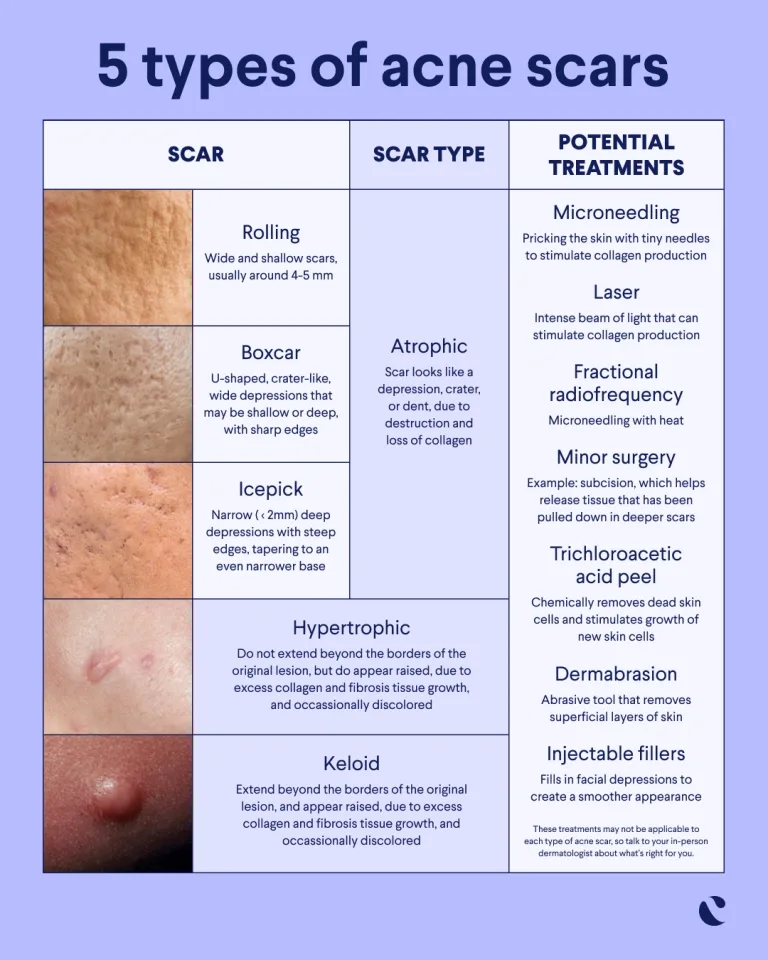How it works:
Share your skin goals and snap selfies
Your dermatology provider prescribes your formula
Apply nightly for happy, healthy skin
How it works:
How it works:
Share your skin goals and snap selfies
Your dermatology provider prescribes your formula
Apply nightly for happy, healthy skin
How it works:
How to treat atrophic scars: Here’s what you need to know
Have pitted scars? Here’s how to address them.



Here at Curology, we currently focus on the diagnosis and treatment of acne, rosacea, and anti-aging concerns. We don’t treat many of the conditions mentioned in this article, like atrophic scarring. This article is for information purposes.
Chances are at some point you, like many, have fallen and scraped a knee or nicked yourself while cooking—or you’ve experienced an acne breakout that seemed like it took forever to clear up. When you injure your skin, collagen—a protein that’s an essential building block of your skin—is responsible for healing and fading the scar. But what happens when your body doesn’t produce enough collagen to regenerate all the damaged tissue? Sometimes, the answer is atrophic scarring.
Atrophic scars are pitted or indented scars that occur when your skin heals below the normal layer of skin due to a lack of regenerative tissue. Think of a pothole in the road that isn’t filled all the way up—that’s what the imbalanced skin of an atrophic scar is like. When they occur on parts of your body that are usually visible, like your face, they can become a point of insecurity. But atrophic scars are a normal part of life for many people—and you look just as beautiful with or without them. Here we’ll look at the different types of atrophic scarring and how to treat atrophic scars to reduce their appearance.
What are atrophic scars?
Atrophic scars on your face can result from a variety of factors including chickenpox, severe acne, or surgery on the skin (like removing a mole). These scars form because of inflammation that breaks down the collagen fibers in your skin and prevents full tissue regeneration. There are three kinds of atrophic scars:¹
Boxcar scars: These scars are indentations that have flat bottoms and defined borders (like a small pothole). This type accounts for 20-30% of atrophic scars.
Icepick scars: These scars are narrow and often deep, sometimes resembling a “V” shape. This type comprises 60-70% of atrophic scars.
Rolling scars: These scars lack the distinct edges of the other two types and tend to be wider. This type of scar accounts for 15-25% of atrophic scars.

Can atrophic scars be removed?
It’s natural to wonder, “Do indented scars fill in over time?” Unfortunately, these scars won’t disappear on their own. Atrophic scars rarely go away completely, but with the help of a dermatology provider, you may be able to successfully reduce their appearance. While some at-home treatments may be marginally effective, to truly address these scars, you’ll need in-office treatment from a dermatology provider. The type of scarring you have determines the treatment that will be most effective—which is something a medical professional will also be able to help you with.² Punch excision, for example, is a treatment often used on icepick scars, while rolling scars are often treated with a procedure known as subcision. There are variations, of course, so listen carefully to the advice of your medical provider.
What can be done?
Your dermatology provider may recommend one or several of the following treatments for reducing the appearance of atrophic scars. (Remember, these are complex procedures that should only be performed by a licensed medical professional; never try them yourself at home):
Fillers: These injections can raise the indented scars to help match the undamaged layer of skin above.
Chemical peels: Topical chemicals applied to the face help remove the damaged layer of skin and cause it to peel, producing a fresh layer of skin underneath—a process known as skin resurfacing.
Microneedling: A group of tiny needles punctures the skin, promoting new collagen production and regenerating a healthier layer of skin.
Subcision: A needle loosens the area around the scar and creates a new wound that may heal properly.
Punch excision: An instrument the size of your scar is used to cut out the scar tissue, helping the skin to regenerate.
Topical retinoids, which you can purchase over the counter, are an at-home remedy that may slightly reduce the appearance of your scars. Finding and atrophic scar treatment with a creamcontaining retinol, for example, can be accomplished with a trip to the pharmacy. Prescription retinoids like tretinoin, which can be found in some Curology formulas, may also help improve the appearance of scars. However, for noticeable results, you may need to book an appointment with a dermatology provider for in-office treatment.
Reducing scars: 4 strategies to consider
Correctly identify the type of atrophic scarring you’re experiencing with the help of a dermatology provider. Your treatment may be different if you have icepick versus boxcar vs rolling scars.
Consider effective treatment options with your provider; they’ll walk you through the risks, side effects, and benefits associated with each option, from microneedling to fillers.
Wondering how to prevent atrophic scars? Consider lifestyle changes and develop a skincare routine that will help you prevent breakouts and acne scars before they develop. This may include using gentle products and effective topical ingredients, like benzoyl peroxide.
Protect your skin from the sun to help decrease the loss of collagen³ that may leave you more susceptible to scarring. Always wear SPF, even on overcast days.
Your scars don’t define you
There aren’t any quick fixes for atrophic scars—we wish we could tell you otherwise. But you’re not alone. Atrophic scars are the most common type of acne scarring. Scars and imperfections are a part of everyday life, and that makes them perfectly normal.
Following the advice of your dermatology provider may effectively reduce the appearance of scar indentations and pigmentation, but that process may require a combination of various treatments. So, if addressing the appearance of your scars is something you want to pursue, stick with it. And don’t feel pressure to undergo treatment for your facial scars if that’s something you’re not interested in. If you feel happy and confident in your skin, that’s all that matters!
FAQs
How long do atrophic scars take to heal?
Healing time depends on your unique skin and scars, but you should expect the process to take at least a few weeks. How long your scars take to heal also depends on what treatments you underwent to address them. Some take longer than others.
Can atrophic scars be completely removed?
Atrophic scars don't always go away entirely with treatment. If you opt for less invasive treatment options, such as fillers and peels, you may still have residual scarring after undergoing treatment. However, many treatments can be combined or repeated for more effective results. If you want to completely eliminate your scars and they fall on the larger side, your dermatology provider may discuss treatments like punch excision with you.
Does retinol help atrophic scars?
While topical retinol—or other retinoids—may offer slight improvements to the appearance of atrophic scars, it’s unlikely that the results will be significant. To effectively treat scar tissue, you need to speak with a dermatology provider and undergo in-office treatment.

Curology can help prevent breakouts
The best way to prevent scarring from acne is to prevent acne from happening in the first place. Curology was founded by dermatologists whose mission is to create accessible solutions to common skincare concerns such as acne, rosacea, and signs of aging. Our service is provided by a dermatology team with more than 1000 years of combined experience. We help take the guesswork out of your skincare routine—licensed dermatology providers work with you to examine your skin, assess your skincare goals, and provide custom treatment options.
Get your personalized skincare routine with Curology
Get your personalized skincare routine with Curology


Becoming a member is easy. Just answer a few questions and snap a few selfies to help us get to know your skin. If Curology is right for you, we’ll pair you with one of our in-house licensed dermatology providers, who will recommend a personalized prescription formula and other effective skincare routines and products for treating your acne. And your first month is on us!* Just pay $5.45 (plus tax) to cover shipping and handling and your personalized Curology formula and other recommended products will show up at your door. Sign up now!
FAQs
Healing time depends on your unique skin and scars, but you should expect the process to take at least a few weeks. How long your scars take to heal also depends on what treatments you underwent to address them. Some take longer than others.
Atrophic scars don't always go away entirely with treatment. If you opt for less invasive treatment options, such as fillers and peels, you may still have residual scarring after undergoing treatment. However, many treatments can be combined or repeated for more effective results. If you want to completely eliminate your scars and they fall on the larger side, your dermatology provider may discuss treatments like punch excision with you.
While topical retinol—or other retinoids—may offer slight improvements to the appearance of atrophic scars, it’s unlikely that the results will be significant. To effectively treat scar tissue, you need to speak with a dermatology provider and undergo in-office treatment.
P.S. We did the homework so you don’t have to:
Connolly, D., et al. Acne Scarring – Pathogenesis, Evaluation, and Treatment Options. The Journal of Clinical and Aesthetic Dermatology. (2017, September).
Jacob, C.I., et al.Acne Scarring: A Classification System and Review of Treatment Options. Journal of the American Academy of Dermatology. (2001, July).
Rittié, L., and Fisher, G. J.Natural and Sun-Induced Aging of Human Skin. National Library of Medicine. (2015, January).
Kristy Simbulan is a board certified Nurse Practitioner at Curology and Agency. She received her Masters Degree in Advanced Practice Nursing from San Diego State University in San Diego, CA.
* Subject to consultation. Subscription is required. Trial is 30 days. Results may vary.

Curology Team

Nicole Hangsterfer, PA-C
Related Articles
The 5 best chemical exfoliators for glowing skinThe ultimate guide to face exfoliators: Our 5 picks for glowing skinWhich tretinoin is right for you, according to Vogue? How to help stop a rash from spreading, according to skin experts A simple guide to skincare for menPopular Articles
Ask Curology: Is my cold breaking me out?Slugging: The dermatologist-approved skincare hack going viral on TikTokTretinoin vs retinol: What’s the difference?How to create a self-care routine that actually sticksYour 2023 skincare horoscopeTry prescription skincare
Get routine essentials


Get clearer skin with Custom FormulaRX
Get clearer skin with Custom FormulaRX
- Breakouts
- Clogged pores
- Whiteheads
- Redness
- Blackheads
$29.95/month